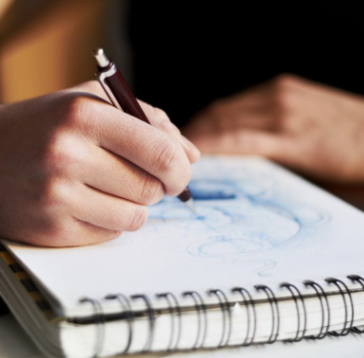
Happy NaNoWriMo everyone! I always think NaNoWriMo month is a good time to talk about what to do when you’ve got a big messy bunch of words and you’re wondering, what’s next?
Here’s an idea: Doodle.
Don’t @ me about your drawing ability! You don’t have to be Amy Sherald or John Singer Sargent to doodle. You just need a pencil.
“Drawing can enrich your writing life, regardless of its visual appeal,” writes Rebecca Fish Ewan in her very fun book Doodling for Writers (Hippocampus Books). “If your drawings help thoughts form and emerge from your mind, they are useful drawings.”
Where to start? Fish Ewan suggests making lists —your chapters, your scenes, or the paragraphs of your short story. Then create a doodle for each one.
When writing her forthcoming book The Truth About Unringing Phones (Unsolicited Press), author Lara Lillibridge first listed all the flash essays she’d written so far, and color-coded them.
Then she created a notecard with a unique doodle for each one. She laid the cards out on her floor, shuffling them until a structure emerged.
“I never write in order. I write what is most pressing emotionally in the moment,” she said. “It is much faster to see the doodle and remember what that segment was about than to read a written description.”
Doodling can help you notice themes or see the outline of a plot. It can also surprise you, because it sometimes leads to what graphic novelist Lynda Barry calls “deep play”— when your doodles talk back.
“There is a reciprocity … that is a lot like a very good conversation,” Barry said. “The relationship between me and my drawing depended on that state of deep play, a certain state of mind that is not planning, not thinking, it’s some other thing.”
Exciting things can happen in that other state. Once, for an essay, I struggled to describe the idiosyncratic layout of my childhood attic bedroom. So I sketched it. But then I kept going, doodling my dolls and the funky built-in drawers in the walls. And I remembered a long-forgotten incident when I discovered my grandfather’s World War I pistol stashed in the closet. That memory helped me move the essay forward.
Getting unstuck is one reason Erin Entrada Kelly doodles while writing, but it’s not the only one.
“I doodle all the time. They ultimately don’t have any value to what I’m working on, but they help me focus and keep me creative,” Erin says. “When we grow up, we sometimes forget to be creative. I seize every opportunity to flex my creative muscles so they don’t atrophy.”
If you’d like to see a recent doodle by Erin, or how Lara Lillibridge used doodles to organize one of her essays, click here. Then close your computer and pick up your drawing pencil, and play. You’ll be surprised at what happens next.

Dean of Faculty


